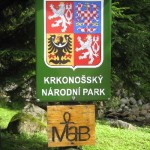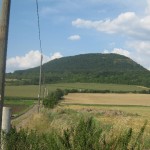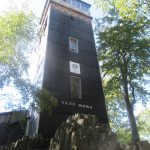
The historic small city of Kutná Hora lies about 70 kilometres east of Prague and it took us around an hour and twenty minutes to drive there on Tuesday 24th July. It is a popular place to visit on a day trip from Prague and of all the places we visited during our recent ‘staycation’, it was the one where we saw greatest number of other tourists.

During early mediaeval times, Kutná Hora was as significant a settlement as Prague, its wealth coming from the mining of silver in the surrounding hills. It was here that silver groschen were minted which was the hard currency of Central Europe during that time. However, a combination of the silver ore being depleted and the city being ravaged by both sides during the Thirty Years War, led to the city’s decline. It now has a population of 21,000 as against Prague with 1.3 million!
The crowning glory of Kutná Hora is its Cathedral, dedicated to St. Barbara, the patron saint of miners. It was begun in the late fourteenth century and was mainly completed by the middle of the sixteenth century. Its current form dates from restoration work undertaken in the late nineteenth and early twentieth century when a series of impressive stained glass windows were added.
|
|
|
Whilst the stained glass is relatively modern, frescos such as these below, date from mediaeval times. The sheer height of the nave, looking towards the high altar, is extremely impressive.
|
|
|
Following the upheavals of the Thirty Years War, the Jesuits arrived in Kutná Hora in the latter part of the seventeenth century, as part of the re-catholization of Bohemia that followed the defeat of the Hussites and their supporters. They were responsible for building a very large Jesuit College and various other buildings and Churches within the city. On the opposite side of the street that runs alongside the Jesuit College towards the Cathedral, is a wall with a series of statues of a variety of saints, the arrangement being apparently inspired by the statues on Charles Bridge in Prague.


Everywhere you look around Kutná Hora the architecture is quite stunning. In writing and illustrating this post, it is difficult to know what to leave out 🙂 However I couldn’t omit this Church, dedicated to St. James. If you look closely, you will see that it is incomplete. It was supposed to have a second tower but only the base was ever built which now has a simple roof and cross constructed on top of it.
Located in the outer suburb of Sedlec is the other main visitor attraction in Kutná Hora – probably the most famous ossuary in the whole of the Czech Republic. It is far better known and receives far more visitors than the ossuary at Melník that we visited the previous week. It is to be found in the crypt of All Saints Church and was created in the late nineteenth century by a local woodcarver, after the Schwarzenberg family purchased the buildings making up the former Sedlec Monastry.
Within the crypt, the remains of about 40,000 people have been rearranged to create, (amongst other things), a chandelier and the coat of arms of the Schwarzenberg family. In both a leaflet we were given and in a guidebook that I have, there is great emphasis that this creation is to remind us all of the transience of human life and the undeniable fact of death. It is right and proper that we are reminded of these things but I have to say that it is a rather unusual way of doing so.
|
|
|











Wonderful architecture and photos, Ricky, but I have to admit to finding the ossuary creations gruesome. I’ve really enjoyed your staycation posts. Thanks for taking us along. 🙂
Fascinating but a little gruesome I have to agree Perpetua. Having seen both the ossuary at Melník and this one at Sedlec on the outskirts of Kutná Hora, we declined the possibility of seeing a third one in Brno last weekend. I’m very glad to know you’re enjoying having a virtual tour of various places in the Czech Republic. There are a couple of more posts to come, hopefully compiled during the next few days.
The Schwarzenberg family has significant emblems that seem to communicate “don’t even THINK of messing with us.” First, this, and then their coat-of-arms bearing the rolling head of a Turk. It certainly gives one pause when first seen!
Indeed it does Karen! Do families revise their historical coat of arms in order to be politically correct in the 21st century?
I saw the ossuary in Sedlec as a child, and wish never, ever, to repeat that experience.
While I rather wish to repeat the experience of a service in the St. Barbara church, during a youth meeting of my church. We were kindly allowed to have the Sunday service there, and it was awesome – the openness of that space, mostly. The church is huge, and you can see it from far away when you are in the area. But I didn’t realise just how huge it was until I saw it from far away… when I was there, I only experienced that aforementioned openness of the space. Maybe it helps when it is filled with people at service. Maybe I’d have a different experience if I visited it as a tourist. And that’s why I’m so grateful for that opportunity to experience it as it was meant to be: as a church.
Hi Hana – as always, it is important to remember that the prime purpose of a Church or Cathedral is for Christian worship and not just for visiting tourists! I’m very glad to know that you’ve had that experience in St. Barbara’s Cathedral in Kutná Hora & that it remains so memorable to you.
Actually, the silver mines were never depleted and the town was already of low importance during the Thirty Years War.
The real cause of the decline was the discovering of America abundant in much cheaper silver.
Hello Wer & welcome to the blog. With regard to my comments about the silver mines, I was only quoting what I found in my guide book to Kutná Hora. But I do accept that finding a cheaper source of silver elsewhere in the world would equally result in a decline in the city’s fortunes.